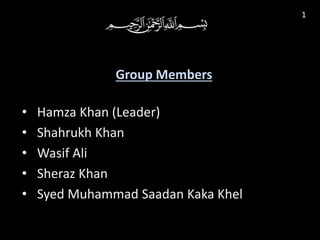
Syntax & Semantics
- 1. 1 Group Members • Hamza Khan (Leader) • Shahrukh Khan • Wasif Ali • Sheraz Khan • Syed Muhammad Saadan Kaka Khel
- 2. 2 Semantics • Word meaning • Importance of semantics • Semantics roles Syntax • Ambiguity • Recursion • Tree Structure Presentation Topics
- 3. What is Semantics? Semantics is the study of meanings in words, phrases and sentences. In semantics there is always an attempt to focus on what the words conventionally means, rather than on what a speaker might want the words on a particular occasion. 3
- 4. Meanings of a Word Conceptual meanings: In Semantics, conceptual meaning is the literal or core sense of a word. Also called denotation or cognitive meaning. For example: “Needle” – thin sharp steel instrument. Associative meanings: In Associative meaning you may have ‘association’ or ‘connotations’ attached to a word. For example: “Needle” – Pain, Blood, Hard to find. 4
- 5. Conceptual vs Associative meanings When linguist investigates the meaning of words in a language they are normally interested in characterizing the conceptual meaning and less concerned with associative meaning of words. However, poets and advertisers are very interested in using terms in such a way that their associative meanings are evoked. 5
- 6. Importance Of Semantics “Colorless green ideas sleep furiously” is a sentence composed by Noam Chomsky in his 1957 book Syntactic Structures as an example of a sentence that is grammatically correct, but semantically wrong. Semantics gives us the ability to know if a sentence is correct in terms of meanings. 6
- 7. Semantic Roles Words are not just “containers” of meanings. They fulfill different “roles” within the situation described by a sentence. For example: If the situation is a simple event Such as, The boy kicked the ball The verb ‘kicked’ describes an action. The noun phrase ‘The boy’ & ‘the ball’ describe the roles of bodies such as people and things involved in the action. 7
- 8. Semantic Roles Agent: The entity that perform the action is technically known as “agent”. For example: The boy kicked the ball. • Agents are usually humans, they can also be non humans forces, machines or creatures For example: The wind blew the ball away Theme: The entity that is involved in or affected by an action is technically known as “theme”. For example: The boy kicked the ball. • In this sentence “ball” is the theme because it is affected by an action performed by the ‘agent’. 8
- 9. Semantic Roles Experiencer: If a person feels something in a noun phrase, He/She fills the role of an experiencer. If we see, know or enjoy something, we do not perform any action. In this way we are in the role of experiencer. For example: Did you hear that noise? The experiencer is“you” and the theme is “that noise”. Source: Place/ location from which something moves. For example: The baby crawled from the kitchen to the door. 9
- 10. Semantic Roles Goal: Place to which something moves. For example: He threw a stone at me. Instrument: A thing that an agent uses to implement an event. For example: Someone cut the bread with a knife. 10
- 11. Lexical Relations Words are not only the ‘containers’ and fulfilling ‘roles’. They can also have ‘relationships’. Synonymy refers to words that are pronounced and spelled differently but contain the same meaning. Example: Happy, joyful, glad Antonymy refers to words that are related by having the opposite meanings to each other. Example: Dead, alive Homonymy refers to the relationship between words that are spelled or pronounced the same way but hold different meanings. Example: bark (the sound of a dog) and bark (the skin of a tree). 11
- 12. What is Syntax? The arrangement of words and phrases to create well formed sentences in a language. The word “Syntax” originally comes from Greek and literally means “putting together” or “arrangement.” Rules for proper arrangement of words in English Grammar/Syntax S + V + O 12
- 13. What is Syntax? Syntax is not about meaning! Sentences can have no sense and still be grammatically correct Incorrect sentence should be marked with a star (*). For example: He eats a car. - nonsense, but grammatically correct . *Car a eats he. - Grammatically incorrect. 13
- 14. Ambiguity The Property of having two or more meanings. Structural ambiguity: A “sentence/phrase” that has two or more than two meanings. For example: I saw a man with a telescope. (Who has the telescope, me or the man?) Lexical ambiguity: A “word” that has two or more than two meanings. For example: We saw her duck. (We saw her pet animal.) (We saw her bend to avoid something.) 14
- 15. Recursion In syntax ‘recursion’ is the repeating of something in a sentence. We can repeat Noun Phrase (NP) in a sentence as long as it makes sense. For example: The gun was on the table. Adding another NP (near the window) & (in the bedroom) The gun was on the table near the window in the bedeoom. Putting sentences inside other sentences/phrases. For example: I helped him Adding “She knew” in the upper sentence. She knew that I helped him. 15
- 16. Tree Diagram Tree diagram provides us a visual representation of a sentence structure. Symbols used in tree diagram Sentence – S Adjective – Adj Noun Phrase – NP Adverb - Adv Verb Phrase – VP Preposition – Prep Prepositional Phrase – PP Article - Art Noun – N Verb - V 16
- 17. Tree Diagram 17
- 18. 18 You may ask any question you have in your mind. Thank You!